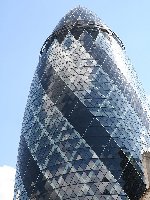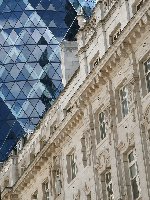

St
Mary Axe
30 St Mary Axe from Bishopsgate and from Great St
Helens
There are many buildings along the street called St Mary Axe, but one of them stands out above all others, both metaphorically and literally; no.30, also known as the Swis Reinsurance Tower, and popularly known as the Gherkin.
St Helens Court; 30 St Mary Axe and the Aviva
Building
30 St Mary Axe is
590 ft tall and was constructed in 2003. It was designed by Norman
Foster & partners and constructed by Skanska. The first new
highrise in London for over 20 years, it was the City of London's
response to Canary Wharf, a reaction to the slow but continual movement
of the big financial institutions to the new, spacious buildings in
Docklands. The Gherkin's striking cylindrical ellipsoid shape and its
superb glass cladding have quickly established it as one of London's
major icons. Its popularity has paved the way for several other iconic
skyscrapers that will soon be joining it on the City's skyline.
30 St Mary Axe, a portfolio
Other buildings in St Mary Axe
30 St Mary Axe reflected in glass facades on
nearby Bury St
The
Lloyds Building
Lloyds of London, from Fenchurch Street
Lloyds of London is an institution dating bacck over three hundred years. It is, essentially, an insurance market and consists of a complex stucture of insurance underwriting syndicates, agents and brokers. Lloyds has operated from the present site since 1928. The building seen here is a replacement, designed by architect Richard Rogers, and was completed in 1986. The building has an "inside-out" concept in that all the services such as water pipes, cable ducts, stairwells and lifts are located on the exterior, leaving the interior completely uncluttered. The interior is in fact the building's real glory; its centrepiece is a 200ft high central atrium surrounded by galleries and lit via a vaulted glass roof. The Fenchurch St facade of the original building has been retained.
Exterior shots of the Lloyds Building
![]() Lloyds of London, and the Lloyds
Building
Lloyds of London, and the Lloyds
Building
The
Willis Building
The three tiers of the Willis building from
Undershaft
The Willis Building
The Willis Building is at 31 Lime Street, immediately opposite Lloyds of London to the east. Designed by Norman Foster for British Land, it was begun in 2006 and has recently been completed; at the time of writing it is being fitted out for its principal tenants, the Willis Insurance group. The most elegant feature of the building is its three steps, respectively 68, 97 and 125 metres (410 ft) high. Its other major attraction is the sheer curved wall of glass forming its western elevation, in which the Lloyds building is beautifully reflected. The development also includes a smaller building to the east with identical cladding.
The west elevation and reflections of the Lloyds
building
The Willis Building from Lime Street
Plantation
Place
Plantation Place
Plantation Place from the west
Plantation Place,
at 31-35 Fenchurch St, was built in 2004 and was designed by Arup for
British Land. It occupies a whole city block between Fenchurch St, Rood
Lane, Eastcheap and Mincing Lane, and is occupied by a variety of
financial companies. The larger of the two buildings is 231 ft high.
The detailing of the building, particularly the glass cladding of the
upper floors, is magnificent; however, the building as a whole has been
criticised as being excessively bulky. This bulkiness is most apparent
in views of the City from the south bank.
The main building
has a 150 ft atrium as its centrepiece and is said to feature three
quarters of an acre of room gardens.
Plantation Place, the north elevation
Minster
Court
Minster Court
Constructed in
1990 and designed by GMW Architects, Minster Court doesn't exactly hide
itself away. A complex of three buildings occupying a whole city block
between Mark Lane and Mincing Lane, it's either a building of
breathtaking audacity or a gothic nightmare, depending on your point of
view. Personally, I love it. The principal tenant is the London
Underwriting Centre. I'm told that Minster Court featured as Cruella de
Vil's mansion in the film "101 Dalmations".
Minster Court, A Portfolio
![]() The London
Underwriting Centre
The London
Underwriting Centre
Fenchurch Place
Buildings on Fenchurch Place
The quiet little square formed of Fenchurch Place and London Street is yet another architectural showcase. The Victorian facade of Fenchurch Street Station opens onto the square yet it looks a little incongruous among the smart new developments; the AIG headquarters building at 58 Fenchurch St, the Lloyds Bank building at 60 Fenchurch St, and the Lloyds Register of Shipping at 71 Fenchurch St. The latter building, by Richard Rogers, is entered via St Katherines churcyard. Lloyds Register is entirely seperate from Lloyds of London, just along the road, but the two institutions had their origins in the same seventeenth century coffee house.
Lloyds Register, Lloyds Bank and the AIG building
on Fenchurch Place
Another new
building at 64 Mark Lane will soon be under consttruction on the south
side of the square.
![]() Richard Rogers's Lloyds
Register webpage
Richard Rogers's Lloyds
Register webpage
Coming
Soon
Two major projects
have planning consent in this part of the city; 122 Leadenhall St, for
which preparation works are already under way, and 20 Fenchurch St,
where the present building is being demolished.
122 Leadenhall St
is by Rogers Stirk Harbour partnership (formely Richard Rogers), for
British Land, and when completed in 2010 it
will briefly become the tallest building in the City of London (before
being overtopped by the Pinnacle on Bishopsgate). It will be 225 metres
(736 ft) high with 52 floors. The southern elevation will be tapered,
with the result that the building will become slimmer towards the top.
The base will feature a 90 ft public atrium.
The following
images are artists' renderings of the building; these images are the
copyright of City Scape.
The future 122 Leadenhall St (copyright City Scape)
![]() British Land's Webcams
of the construction site
British Land's Webcams
of the construction site
![]() Skyscraper City's 122
Leadenhall forum
Skyscraper City's 122
Leadenhall forum
20 Fenchurch Street is not yet definate though the present building is
under demolition. Unlike 122 Leadenhall it is actually designed to be
broader at the top than at street level. It has been designed by Rafael
Vinoly for Land Securities. Earlier designs attracted great criticism
but later redesigns have seen it become much more slender and pleasing
to the eye. It will have 36 floors and will stand 525 ft high. A major
feature will be the public roof gardens occupying the three highest
floors.
These artists'
impressions of 20 Fenchurch St are the copyright of Miller Hare.
![]() Map
of Fenchurch St / Leadenhall St and aerial photos by
Streetmap.co.uk
Map
of Fenchurch St / Leadenhall St and aerial photos by
Streetmap.co.uk
![]() Back to City of London index page
Back to City of London index page
This page last updated 2nd February 2008
![]()